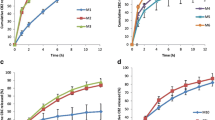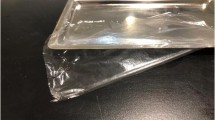ABSTRACT
Development of palatable formulations for pediatric and geriatric patients involves various challenges. However, an innovative development with beneficial characteristics of marketed formulations in a single formulation platform was attempted. The goal of this research was to develop solid oral flexible tablets (OFTs) as a platform for pediatrics and geriatrics as oral delivery is the most convenient and widely used mode of drug administration. For this purpose, a flexible tablet formulation using cetirizine hydrochloride as model stability labile class 1 and 3 drug as per the Biopharmaceutical Classification System was developed. Betadex, Eudragit E100, and polacrilex resin were evaluated as taste masking agents. Development work focused on excipient selection, formulation processing, characterization methods, stability, and palatability testing. Formulation with a cetirizine-to-polacrilex ratio of 1:2 to 1:3 showed robust physical strength with friability of 0.1% (w/w), rapid in vitro dispersion within 30 s in 2–6 ml of water, and 0.2% of total organic and elemental impurities. Polacrilex resin formulation shows immediate drug release within 30 min in gastric media, better taste masking, and acceptable stability. Hence, it is concluded that ion exchange resins can be appropriately used to develop taste-masked, rapidly dispersible, and stable tablet formulations with tailored drug release suitable for pediatrics and geriatrics. Flexible formulations can be consumed as swallowable, orally disintegrating, chewable, and as dispersible tablets. Flexibility in dose administration would improve compliance in pediatrics and geriatrics. This drug development approach using ion exchange resins can be a platform for formulating solid oral flexible drug products with low to medium doses.






Similar content being viewed by others
REFERENCES
Breitkreutz J. European perspectives on pediatric formulations. Clin Ther. 2008;30(11):2146–54.
Schirm E, Tobi H, de Vries TW, Choonara I, De Jong-van den Berg LT. Lack of appropriate formulations of medicines for children in the community. Acta Paediatr. 2003;92(12):1486–9.
European Medicines Agency. Development of pediatric formulations—points to consider. Workshop on Pediatric Formulations II, London; 2011.
WHO (World Health Organization). Draft annex to 46th Report of the Who Expert Committee on Specifications for Pharmaceutical Preparations. Development of pediatric medicines: points to consider in formulation; 2012.
European Medicines Agency, Committee for Medicinal Products for Human Use (CHMP). Reflection paper: Formulations of choice for the pediatric population. EMEA/CHMP/PEG/196810/2005. 2006.
European Medicines Agency, Committee for Medicinal Products for Human Use (CHMP). Concept paper on the need for a reflection paper on quality aspects of medicines for older people. EMA/165974. 2013.
Breitkreutz J, Boos J. Pediatric and geriatric drug delivery. Expert Opin Drug Deliv. 2007;4(1):37–45.
Khan MA. U.S Department of Health and Human Services Food and Drug Administration. Some challenges in the development of pediatric formulations. FDA; 2012.
Nunn T, Williams J. Formulation of medicines for children. Br J Clin Pharmacol. 2005;59(6):674–6.
Thomson SA, Tuleu C, Wong IC, Keady S, Pitt KG, Sutcliffe AG. Mini-tablets: new modality to deliver medicines to preschool-aged children. Pediatrics. 2009;123(2):235–8.
European Medicines Agency. ICH topic E7. Note for studies in support of special populations: geriatrics. CPMP/ICH/379/95. 1994.
Cram A, Breitkreutz J, Desset-Brèthes S, Nunn T, Tuleu C. Challenges of developing palatable oral pediatric formulations. Int J Pharm. 2009;365(1–2):1–3.
Krause J, Breitkreutz J. Improving drug delivery in pediatric medicine. Pharm Med. 2008;22:41–50.
Ernest TB, Elder DP, Martini LG, Roberts M, Ford JL. Developing pediatric medicines: identifying the needs and recognizing the challenges. J Pharm Pharmacol. 2007;59:1043–55.
Strickley RG, Iwata Q, Wu S, Dahl TC. Pediatric drugs—a review of commercially available oral formulations. J Pharm Sci. 2007;97:1731–74.
FDA. Guidance for industry: orally disintegrating tablets. Chemistry. FDA, CDER. 2008.http://www.fda.gov/downloads/Drugs/.../Guidances/ucm070578.pdf. Accessed 19 Nov 2016.
Hirani JJ, Rathod DA, Vadalia KR. Orally disintegrating tablets: a review. Trop J Pharm Res. 2009;8(2):161–72.
Davies HE, Tuleu C. Medicines for children: a matter of taste. J Pediatr. 2008;153(5):599–604.
Rowe RG, Sheskey PJ, Quinn ME. Handbook of pharmaceutical excipients. London: Pharmaceutical Press; 2009.
Szejtli J. Past, present, and future of cyclodextrin research. Pure Appl Chem. 2004;76(10):1825–45.
Valentino S, Rojer, R. Derivatives of cyclodextrin exhibiting enhanced aqueous solubility and use thereof. US Patent 5,134,127. 1992.
Eichman, ML. Drug-resin complexes stabilized by chelating agents. US Patent 5,980,882. 1999.
Pawar S, Kumar A. Issues in the formulation of drugs for oral use in children: role of excipients. Pediatr Drugs. 2002;4(6):371–9.
Pefferi G, Restani P. The safety of pharmaceutical excipients. Il Farmaco. 2003;58:541–50.
American Academy of Pediatrics, Committee on Drugs. Inactive ingredients in pharmaceutical products. Pediatrics. 1985;76:635–43.
American Academy of Pediatrics, Committee on Drugs. Inactive ingredients in pharmaceutical products: update. Pediatrics. 1997;99:268.
Yamamoto Y, Fujii M, Watanabe K, Tsukamoto M, Shibata Y, Kondoh M, et al. Effect of powder characteristics on oral tablet disintegration. Int J Pharm. 2009;365:116–20.
Late SG, Yu Y-Y, Banga AK. Effects of disintegration-promoting agent, lubricants and moisture treatment on optimized fast disintegrating tablets. Int J Pharm. 2009;365:4–11.
Chen M-L, Straughn AB, Sadrieh N, Meyer M, Faustino PJ, Ciavarella AB, et al. A modern view of excipient effects on bioequivalence: case study of sorbitol. Pharm Res. 2007;24(1):73–80.
Kumar A, Aitas AT, Hunter AG, Beaman DC. Sweeteners, dyes, and other excipients in vitamin and mineral preparations. Clin Pediatr (Phila). 1996;35(9):443–50.
Kumar A, Rawlings RD, Beaman DC. The mystery ingredients: sweeteners, flavorings, dyes, and preservatives in analgesic/antipyretic, antihistamine/decongestant, cough and cold, antidiarrheal, and liquid theophylline preparations. Pediatrics. 1993;91(5):927–33.
Hill EM, Flaitz CM, Frost GR. Sweetener content of common pediatric oral liquid medications. Am J Hosp Pharm. 1988;45(1):135–42.
Subramaniam P, Nandan N. Cariogenic potential of pediatric liquid medicaments—an in vitro study. J Clin Pediatr Dent. 2012;36(4):357–62.
Lu FC. Acceptable daily intake (ADI): inception, evolution, and application. Regul Toxicol Pharmacol. 1998;8(1):45–60.
FDA. Guidance for industry: Q3B (R2) Impurities in new drug products. 2006. http://www.fda.gov/downloads/drugs/guidancecomplianceregulatoryinformation/guidances/ucm073389.pdf. Accessed 18 July 2016.
FDA. Guidance for industry: Q3C Impurities, residual solvents. 1997. http://www.fda.gov/downloads/drugs/guidancecomplianceregulatoryinformation/guidances/ucm073394.pdf. Accessed 18 July 2016.
FDA. Guidance for industry: Q3D Elemental impurities. 2015. http://www.fda.gov/downloads/drugs/guidancecomplianceregulatoryinformation/guidances/ucm371025.pdf. Accessed 18 July 2016.
Nunn AJ. Making medicines that child can take. Arch Dis Child. 2003;88(5):369–71.
FDA. Orange book search. FDA, CDER. http://www.accessdata.fda.gov/scripts/cder/ob/default.cfm. Accessed 19 Nov 2016.
Yu H, Cornett C, Larsen J, Hansen SH. Reaction between drug substances and pharmaceutical excipients: formation of esters between cetirizine and polyols. J Pharm Biomed Anal. 2010;53:745–50. doi:10.1016/j.jpba.2010.05.001.
Goel H, Rai P, Rana V, Tiwary AK. Orally disintegrating systems: innovations in formulation and technology. Recent Pat Drug Deliv Formul. 2008;2:258–74.
Seager H. Drug-delivery products and the Zydis fast-dissolving dosage form. J Pharm Pharmacol. 1998;50:375–82.
Satishkumar JP, Mehta DC, Shah SP, Singh PP, Amin PD. Melt-in-mouth pellets of fexofenadine hydrochloride using crospovidone as an extrusion–spheronisation aid. AAPS PharmSciTech. 2010;11(2):917–23.
Preis M. Orally disintegrating films and mini-tablets—innovative dosage forms of choice for pediatric use. AAPS PharmSciTech. 2015;16(2):234–41. doi:10.1208/s12249-015-0313-1.
Bhise K, Shaikh S, Bora D. Taste mask, design and evaluation of an oral formulation using ion exchange resin as drug carrier. AAPS PharmSciTech. 2008;9(2):557–62. doi:10.1208/s12249-008-9056-6.
Ishizaka T, Miyanaga Y, Mukai J, Asaka K, Nakai Y, Tsuji E, et al. Bitterness evaluation of medicines for pediatric use by a taste sensor. Chem Pharm Bull. 2004;52(8):943–8.
Roberts R, Rodriquez W, Murphy D, Crescenzi T. Pediatric drug labeling. Improving the safety and efficacy of pediatric therapies. JAMA. 2003;290(7):905–11.
FDA. Orange book: approved drug products with therapeutic equivalence evaluations. http://www.accessdata.fda.gov/drugsatfda_docs/label/2012/019835s032lbl.pdf. Accessed 17 July 2016.
ACKNOWLEDGEMENTS
The authors would like to express gratitude to Orchid Healthcare Limited, India, and Novel Laboratories Inc., Bangalore, for supporting this research work. The authors kindly acknowledge the Department of Science and Technology, New Delhi, Govt. of India, for its efforts in establishing the National Facility for Drug Development for Academia, Pharmaceutical and Allied Industries at Bharathidasan Institute of Technology, Anna University, Tiruchirappalli, and for providing constant support.
Author information
Authors and Affiliations
Corresponding author
Rights and permissions
About this article
Cite this article
Chandrasekaran, P., Kandasamy, R. Development of Oral Flexible Tablet (OFT) Formulation for Pediatric and Geriatric Patients: a Novel Age-Appropriate Formulation Platform. AAPS PharmSciTech 18, 1972–1986 (2017). https://doi.org/10.1208/s12249-016-0666-0
Received:
Accepted:
Published:
Issue Date:
DOI: https://doi.org/10.1208/s12249-016-0666-0




